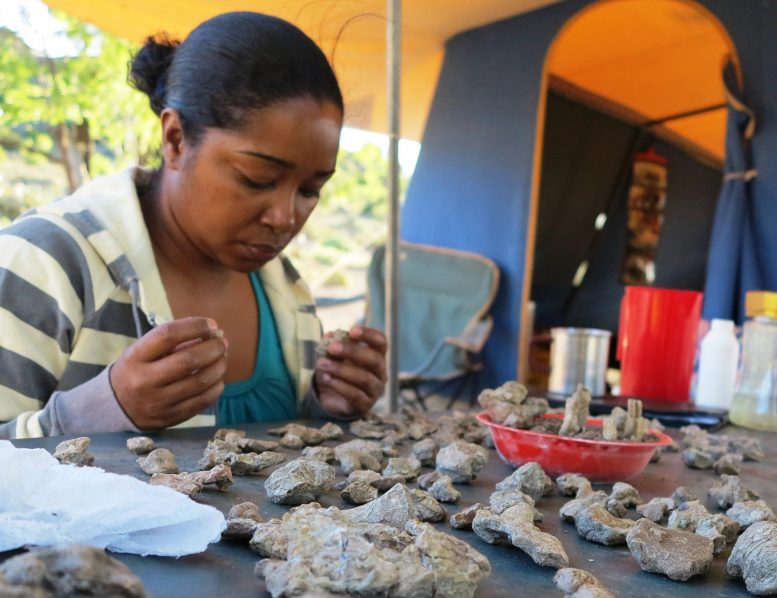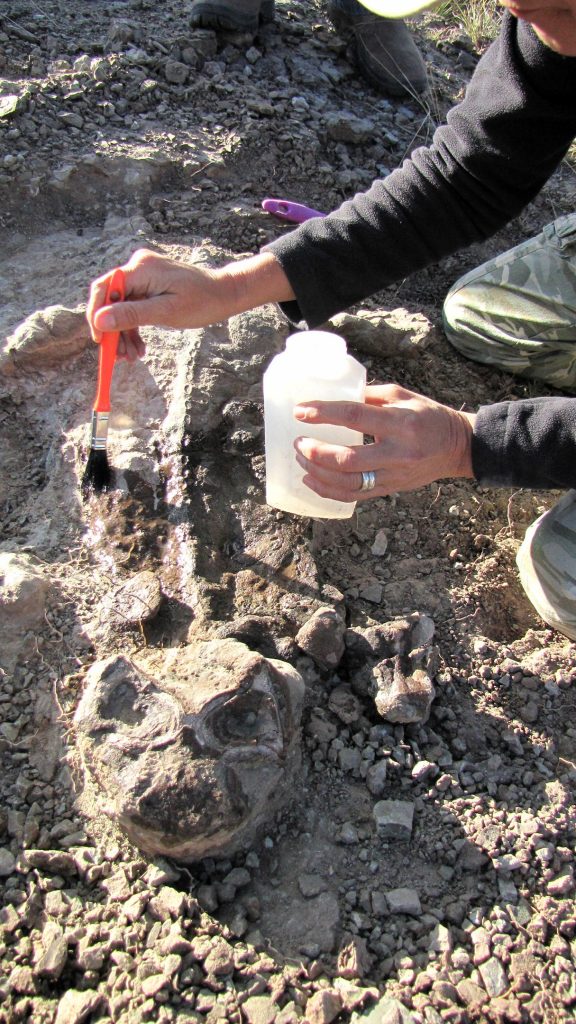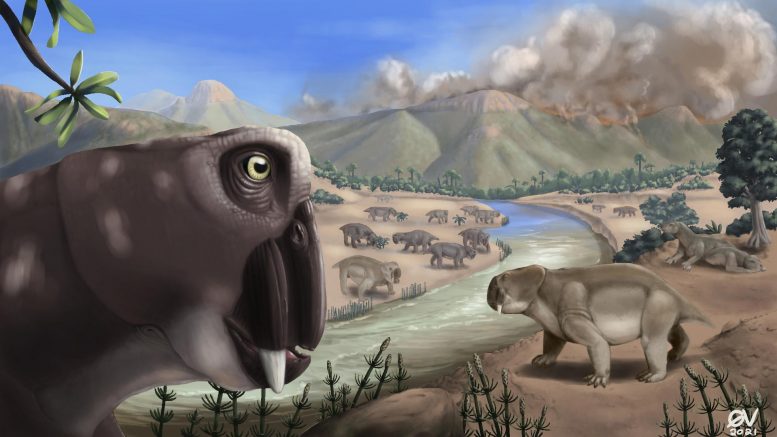Our planet’s worst mass extinction event happened 252 million years ago when massive volcanic eruptions caused catastrophic climate change. The vast majority of animal species went extinct, and when the dust settled, the planet entered the early days of the Age of Dinosaurs. Scientists are still learning about the patterns of which animals went extinct and which ones survived, and why. In a new study in PNAS, researchers found that while extinctions happened rapidly in the oceans, life on land underwent a longer, more drawn-out period of extinctions.
“People assumed that because the marine extinction happened over a short period of time, life on land should have followed the same pattern, but we found that the marine extinction may actually be a punctuation to a longer, more drawn-out event on land,” says Pia Viglietti, a postdoctoral researcher at Chicago’s Field Museum and the lead author of the PNAS study.
“The focus for studying terrestrial extinction has basically been, ‘Can we match up the pattern in the terrestrial realm with what’s observed in oceans?’ And the answer is, ‘Not really,’” says Ken Angielczyk, the paper’s senior author and curator of vertebrate paleontology at the Field Museum. “This paper is the first really focusing on vertebrates and saying, ‘No, something was going on that was unique to the terrestrial realm.’”

Zaituna Skosan, Collections Manager at Iziko Museum in Cape Town, South Africa, glues together a broken up fossil during fieldwork in the Karoo Basin. Credit: Roger Smith
Part of why scientists had looked to the marine extinctions for clues as to what happened on land is that there’s a more complete fossil record of life underwater. If you want to become a fossil, dying by water, where your body will rapidly get covered by sediment, is a good way to make that happen. As a result, paleontologists have known for a while that 252 million years ago a mass extinction hit at the end of the Permian period, and within 100,000 years, more than 85% of the species living in the ocean went extinct. And while that seems like a long time to us, that’s very quick in geologic time. The marine version of the end-Permian extinction took up 100,000 years out of the entire 3,800,000,000 years that life has existed—the equivalent to 14 minutes out of a whole year.
To learn what happened to life on land, Viglietti, Angielczyk, and their colleagues examined fossils from 588 four-legged fossil animals that lived in what’s now South Africa’s Karoo Basin at the time of the Permian mass extinction.
“The region where we found the fossils for this study is absolutely beautiful. The green mountainous slopes are so inviting on a crisp summer morning, it makes the heat that is still to come bearable,” says Zaituna Skosan, the paleontology collections manager at the Iziko South African Museum and one of the paper’s co-authors. “Finding good fossils is the best feeling, but also short lived as you must focus and continue to look for your next find. Even the best fossil finder overlooks a great find sometimes.”

A fossil of the dicynodont Lystrosaurus, a mammal relative that survives the end-Permian mass extinction event, is collected during fieldwork in South Africa’s Karoo Basin. Credit: Roger Smith
The researchers created a database and separated the fossils by age, grouping together specimens by 300,000-year time intervals. This approach allowed the researchers to quantify the appearance and disappearance of different species and look at the bigger picture of life over time, rather than just relying on individual specimens to tell the whole story.
“Our approach unifies the data and says, okay, within this time bin we have these species, but as we go up, we have these other species. By applying sampling methods to these bins, we can help correct for issues like having more or fewer specimens collected in different time intervals or places. Ultimately, it lets us quantify how much extinction is happening and how quickly new species are appearing,” says Viglietti. “Instead of putting too much focus on any one fossil, you compile hundreds of observations roughly in the same time interval.”
“To figure out patterns of extinction based on hundreds of fossils we used a type of math called statistics. When a species disappears it could either have gone extinct, or it could still be out there, waiting to be discovered, but so far undetected,” says Roger Benson, a professor of paleobiology at the University of Oxford and one of the study’s co-authors. “We had to deal with that before we could have any confidence about the timing of extinctions. The math is already understood so the statistical work involved writing computer algorithms to extract that all-important signal of extinction from the data.”
One of the species that helped reveal patterns of extinction and recovery was Lystrosaurus, an herbivorous early mammal relative that ranged from the size of a small dog to a cow, depending on the species. “It had a beak and tusks, it wasn’t the most attractive animal, but I have a soft spot for Lystrosaurus because it was like the first animal I studied as a grad student, so coming full circle with Lystrosaurus in this study made me quite happy,” says Viglietti.
Lystrosaurus is what paleontologists call a “disaster taxon”—a group that thrived during a time when most other life was struggling. “Lystrosaurus is like a poster child for the end-Permian extinction that’s always been portrayed as this animal that flourishes in the aftermath of all this extinction and just takes over,” says Viglietti. “But we see Lystrosaurus appearing before the extinction even got started, it was already abundant. It got us thinking about what was driving that abundance—if Lystrosaurus just took over the barren landscape after other animals went extinct, or if the environment was changing and Lystrosaurus adapted to these changes that were causing extinction for all these other species. Our best guess is the latter.”
Examining fossils like Lystrosaurus showed the researchers that the Permian extinction looked very different on land than it did in the oceans—it was a much longer, more drawn-out affair. Using the earlier comparison, if the history of life on Earth were compressed into a single year and the end-Permian extinction killed 95% of the ocean’s animals in a matter of 14 minutes, the land extinction would have taken ten times as long, about two hours and twenty minutes.
It’s not clear exactly why the mass extinction event happened so much more slowly on land. “The changes to the Earth’s climate were cumulative and added up over time. Ecosystems were slowly disrupted, and then it just got to a point where everything collapsed, like the straw that breaks the camel’s back,” says Viglietti. “Everything’s fine, until it’s not.”
One reason for the discrepancy could be that the oceans can absorb chemical changes and stabilize themselves, up to a point. “In today’s climate crisis, the oceans can absorb a lot of carbon dioxide or rise in temperature without people realizing, and then all of a sudden you get sudden ecosystem breakdowns like ocean acidification and coral bleaching,” says Viglietti. The same might be true for the late Permian oceans.
Understanding what happened in the end-Permian mass extinction gives us clues about the rise of the dinosaurs—many of the ancient mammal relatives went extinct, leaving ecological vacancies that dinosaur ancestors evolved to fill. But the end-Permian extinction also provides insights into the mass extinction event that the Earth is currently undergoing due to climate change and habitat destruction.
“The environmental changes that we are causing and the impacts we are having on animal and plant species are getting to the point where the scale is such that there isn’t really anything in human history that is comparable,” says Angielczyk. “The fossil record can give us some idea of what massive biodiversity crises are like and how they proceed.”
“It takes a long time to recover from extinction. When we lose diversity, it’s not going to recover in our lifetime, it’s going to take hundreds of thousands of years, or even millions,” says Viglietti. “Studies like this one show what our society should be focusing on.”
Reference: “Evidence from South Africa for a protracted end-Permian extinction on land” by Pia A. Viglietti, Roger B. J. Benson, Roger M. H. Smith, Jennifer Botha, Christian F. Kammerer, Zaituna Skosan, Elize Butler, Annelise Crean, Bobby Eloff, Sheena Kaal, Joël Mohoi, William Molehe, Nolusindiso Mtalana, Sibusiso Mtungata, Nthaopa Ntheri, Thabang Ntsala, John Nyaphuli, Paul October, Georgina Skinner, Mike Strong, Hedi Stummer, Frederik P. Wolvaardt and Kenneth D. Angielczyk, 27 April 2021, Proceedings of the National Academy of Sciences.
DOI: 10.1073/pnas.2017045118
This study was contributed to by the following authors: Pia A. Viglietti, Roger B.J. Benson, Roger M.H. Smith, Jennifer Botha, Christian F. Kammerer, Zaituna Skosan, Elize Butler, Annelise Crean, Bobby Eloff, Sheena Kaal, Joël Mohoi, William Molehe, Nolusindiso Mtalana, Sibusiso Mtungata, Nthaopa Ntheri, Thabang Ntsala, John Nyaphuli, Paul October, Georgina Skinner, Mike Strong, Hedi Stummer, Frederik P. Wolvaardt, and Kenneth D. Angielczyk.










“… more than 85% of the species living in the ocean went extinct.”
That should be “became extinct” because ‘extinct’ is a state of being. It is commonly said — correctly — that someone went skiing, swimming, fishing, etc. Note that all the activities end in “ing.” Would you say that someone “went ill” or, rather, that they “became ill?”
I realize that languages change with time, and one commonly sees the expression “went extinct.” However, one of the things that English is criticized for are the irregularities in spelling and conjugation. I would hope that Scitechdaily would use their influence to encourage proper grammar, and discourage a drift in usage that adds to the confounding irregularities in English.
Do you have editors?
“In today’s climate crisis, the oceans can absorb a lot of carbon dioxide or rise in temperature without people realizing, and then all of a sudden you get sudden ecosystem breakdowns like ocean acidification and coral bleaching,”
Carbonic acid, resulting from carbon dioxide dissolving in water, is a weak acid and an intimate part of the (bi)carbonate buffering system in the oceans. It is unlikely that the oceans would ever actually become acidic from it, as implied by the misnomer “ocean acidification.” On the other hand, volcanoes produce sulfur and sulfur dioxide (as well as some other strong-acid precursor species such as HCl and HF). When sulfur burns, which it often does in proximity to lava from the volcanoes, it also produces sulfur dioxide. Besides being toxic in the air, it is soluble in water and produces sulfuric acid, a strong acid, which might possibly have actually made the Permian oceans acidic.
Assuming that carbon dioxide is actually as effective in warming the Earth’s atmosphere as current Global Circulation Models assume, then water will only warm a fraction (<20%) of what granite will when absorbing the same amount of heat energy. So, I don't think that we can assume that the Permian oceans were boiling their resident 'lobsters.'
"… it just got to a point where everything collapsed, …" A simplistic assumption that doesn't really explain much. It is akin to Einstein stating that "There's a relationship between energy and mass." Details matter!
Clyde, “someone” is singular “they” is plural; “one” is singular, “are” is plural. Do you have an editor?
As a matter of fact, I don’t have an editor. However, I’m not a journalist writing for an online publication.
And, because Scitechdaily doesn’t allow commenters to correct their comments, I get one shot at getting it right.
How would you phrase the last sentence in the first paragraph? Would you prefer I replace “they” with “he/she/it?”
Perhaps it is you who needs an editor:
https://en.wikipedia.org/wiki/Singular_they
LOL Grammer War!!! Chill out. Take it for what it is, an informative article that will never see a Texas classroom.
You sound like someone who has experience with wearing “Texas T-shirts.”
Mirror your wrong just saying they has singular uses as well my vote is to replace the editor you have with that clyde Spencer guy he didnt even have to say anything
LaughingAtClyde…
It’s spelled ‘grammAr’… Not ‘grammEr’… Jus’ sayin’
😉🤓🤓🤓😇😇😇
I share the same annoyances when it comes to grammar, punctuation, and improper use of words. The way English is used in written format I find literally offensive. I must say I find it WONDERFUL to see someone who shares a similar mindset.
My husband uses the phrase “it’s the thought that counts,” and every time it’s said, I remind him that intention matters. Yes! But outcome matters the same amount, if not MORE! Words are losing their weight I’m sorry to say, in today’s mindset of people 35 and under. (In my experience) I use that to try to make the thought known that one single word or phrase and it’s meaning or context can change an entire works if used incorrectly. More time should be spent on dictionary and thesaurus in schools I swear!
Yes! Yes, I brought it back to grammar, punctuation, and proper editting! YAY for the cool kids!
My bad, and I’m done.
Aw damn.. and there goes autocorrect…
Making my ENTIRE paragraph COMICAL…
Editing… Not editting… Wtf is that.
If you believe that any man regardless of if he is a scientist or a dishwasher knows what the Earth was like 250 million years ago you’re just the type of person I’ve been looking for. I have a bridge in Montana I’d like to sell you? Timeshare?